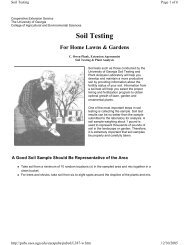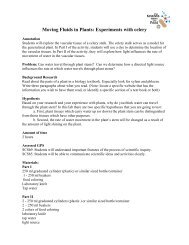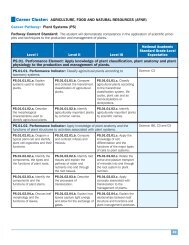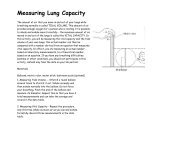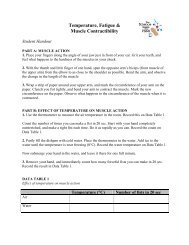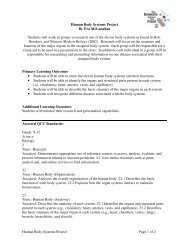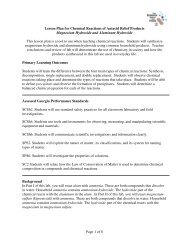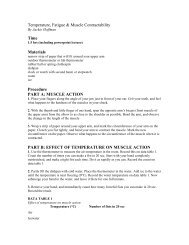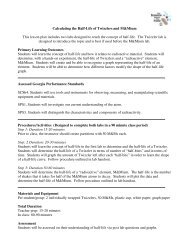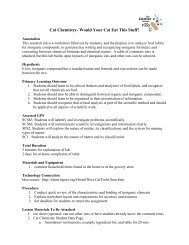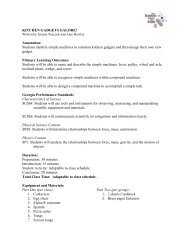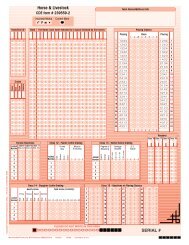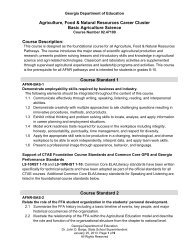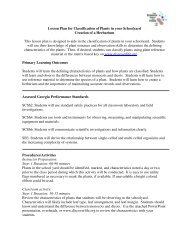Average Speed of a Constant Velocity Vehicle Lab
Average Speed of a Constant Velocity Vehicle Lab
Average Speed of a Constant Velocity Vehicle Lab
Create successful ePaper yourself
Turn your PDF publications into a flip-book with our unique Google optimized e-Paper software.
<strong>Average</strong> <strong>Speed</strong> <strong>of</strong> a <strong>Constant</strong> <strong>Velocity</strong> <strong>Vehicle</strong> <strong>Lab</strong><br />
The purpose <strong>of</strong> this lab is to calculate the speed <strong>of</strong> a constant velocity vehicle (CVV), to<br />
develop skills in precision and accuracy, data collection and calculations related to<br />
average speed. A constant velocity vehicle is a car that mechanically maintains the same<br />
speed, and can be ordered from a science supplies catalog.<br />
Primary Learning Outcome<br />
Students will understand the concept <strong>of</strong> speed and how to calculate average speed, and<br />
they will understand the importance <strong>of</strong> accuracy in data collection.<br />
Assessed GPS<br />
SCSh3<br />
SCSh4<br />
SCSh5<br />
SPS8<br />
SP1<br />
Total Time<br />
Varies with distance and number <strong>of</strong> trials chosen, but allow 1hour for this format to<br />
discuss and conduct the trials, and do calculations.<br />
Materials per group<br />
Data table (attached)<br />
Stopwatch<br />
CVV<br />
Meter stick<br />
Masking tape<br />
Procedure<br />
• Place a piece <strong>of</strong> tape on the carpet- this is the starting line. Determine and<br />
measure the experimental distance and mark the finish line with tape.<br />
• Start the car behind the starting line. Time begins as car crosses front <strong>of</strong> tape and<br />
ends when car crosses front <strong>of</strong> finish line tape.<br />
• Do 3 practice runs to make sure timing is accurate and precise.<br />
• Record time data, and repeat for each trial.<br />
• Calculate the speed for each trial and the average speed <strong>of</strong> all three trials.<br />
• Complete the calculations on the data sheet.<br />
Assessment<br />
Students can be graded based <strong>of</strong>f their answers on the data sheet where they have to<br />
perform the calculations in two directions. The concepts <strong>of</strong> speed and acceleration can be<br />
clarified further after the lab, and similar problems put on a unit test.
Name_______________________<br />
Car #_________<br />
<strong>Average</strong> <strong>Speed</strong> Data Table<br />
Trial<br />
1<br />
2<br />
3<br />
Distance<br />
cm<br />
Time<br />
s<br />
<strong>Speed</strong><br />
cm/s<br />
1) Calculate the speed <strong>of</strong> the vehicle for each <strong>of</strong> the 3 trials. Record your answers in the<br />
table.<br />
2) Find the average speed <strong>of</strong> the 3 speeds you found in #1. Show your work.<br />
3) What observations did you make about the results between the three trials?
4) Using the <strong>Average</strong> <strong>Speed</strong> found in #2, predict how long it should take for the vehicle<br />
to go 300cm (show all four steps). Use the equation s=d/t and solve for t.<br />
5) Repeat the experiment using the same car. This time do 1 trial for a distance <strong>of</strong><br />
300cm.<br />
Record the time: _________sec. This is your experimental (predicted) time.<br />
6) Find the % Experimental Error between the experimental time and the actual time.<br />
Experimental time = ________(see #5)<br />
Accepted time = ________(see #4)<br />
Formula: ⏐experimental time - accepted time⏐<br />
accepted time<br />
x100 =_______



